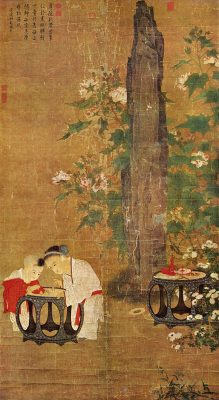The Song Dynasty (960-1279) was a time of great political and economic stability in China. This stability led to the flourishing of the arts. One of the most distinctive features of Song Dynasty art is its focus on realism and detail. This can be seen in the intricate paintings and calligraphy of the period. In addition to these more traditional art forms, the Song Dynasty also saw the growth of genres such as landscape painting and pottery.
Patronage of the Arts
Patronage was an essential part of Song Dynasty culture, and many wealthy families commissioned artworks for their homes. The imperial court also played a role in promoting the arts, and Emperor Huizong (reigned 1100-1126) of the Northern Song dynasty was an artist himself. He established an academy called the Hanlin Huayuan (翰林畫院), where the great masters shared their work with aspiring painters.
Painting, poetry, and calligraphy were part of what was known as “brush art,” as they were commonly done with a brush. Traditionally, painters in China utilized black ink on white paper and didn’t use other colors because the focus was not on color but on the brushstrokes used in the painting. Brush art reached new levels of realism and detail during the Song Dynasty. Artists began to use thinner brushstrokes and more subtlety in their work, as seen in the intricate landscape paintings and calligraphy of the period.
Painting styles varied depending on region and artist, but a few key styles emerged during this period. These include landscape painting, figure painting, and bird-and-flower painting. The use of rolled paper is another intriguing format because it tells a story and creates a visual narrative. As the painting is unrolled, some elements are exposed while others are still hidden, creating a sense of suspense and discovery for the viewer.
The arts also flourished in other media, such as ceramics, which were often decorated with light colors and delicate designs. The most famous type of Song Dynasty ceramic is the Ru ware (汝窯). These pieces are characterized by their bluish-green glaze and simple yet elegant designs. Other types of ceramics from this period include Jun ware (鈞窯), Longquan celadon (龍泉青瓷), and Qingbai ware (青白瓷).
Famous Song Dynasty Artists
1) Li Cheng (李成, 919-967) of the Northern Song Dynasty
He was known for his landscapes, which often depicted imaginary mountain ranges. His work influenced a generation of painters and helped to establish landscape painting as its own genre. One of his popular works was A Solitary Temple Amid Clearing Peaks (孤峰寺), which can still be seen today in the Nelson-Atkins Museum in Kansas City, Missouri.
2) Emperor Huizong (羲宗, 1082-1135) of the Northern Song Dynasty
He was the eighth emperor of the Northern Song Dynasty and was not only a great patron of the arts but was also an artist himself. He sponsored many artists at his court and collected over 6,000 paintings. Despite not being a very successful ruler, he is still remembered for his talents in the arts. He was a painter, poet, calligrapher, and musician. Some of his famous works include the painting Listening to the Qin (聽琴圖) and the Five-Colored Parakeet on Blossoming Apricot Tree (五色鵲飛梅圖). He also invented the Slender Gold style of calligraphy, which was named due to his writing resembling a gold filament.
3) Zhang Zeduan (張擇端, 1085 to 1145) of the Southern Song Dynasty
He was famous for his painting Along the River During the Qingming Festival (清明上河圖). This work is a masterpiece that captures the everyday life of people living along the Bian River. The handscroll painting provides a detailed look at various aspects of life from all levels of society, rich and poor, from their clothing to the types of boats they used. It is considered one of the greatest works of Chinese art, and one of the most famous and well-preserved examples of Song Dynasty painting and can still be seen at the Palace Museum in Beijing today.
There were many other great artists during the Song Dynasty, but these are just a few of the most famous ones. The Song Dynasty was a time of great artistic achievement and innovation that had a lasting impact on Chinese art.
Influence of Buddhism and Neo-Confucianism
Buddhism had been declining in influence, but it still had a stronghold on the arts and charities of monasteries. The Neo-Confucian philosophy was on the rise and greatly impacted the government and education. Both had a big influence on the arts during the Song Dynasty. This is reflected in the art of the time, including Luohan Laundering by Lin Tinggui of the Southern Song Dynasty, which illustrated the daily life of Buddhism monks. The motif of Confucius, Buddha, and Lao Tzu all drinking from the same vinegar jar, called The Vinegar Tasters, was a popular subject in painting and each man’s expression represented the principal attitude of his philosophy. Sour for Confucius because he saw life as sour and in need of rules to correct people’s behavior; bitter for Buddha because he saw life as suffering due to attachment to possessions; and sweet for Lao Tzu because he saw life as fundamentally perfect in its natural state.

